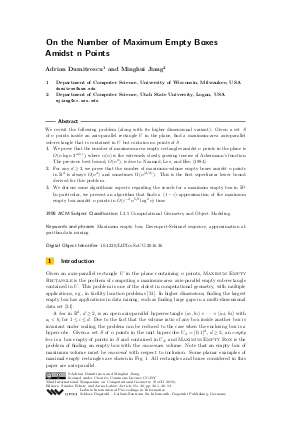On the Number of Maximum Empty Boxes Amidst n Points
Authors Adrian Dumitrescu, Minghui Jiang
-
Part of:
Volume:
32nd International Symposium on Computational Geometry (SoCG 2016)
Part of: Series: Leibniz International Proceedings in Informatics (LIPIcs)
Part of: Conference: Symposium on Computational Geometry (SoCG) - License:
 Creative Commons Attribution 3.0 Unported license
Creative Commons Attribution 3.0 Unported license
- Publication Date: 2016-06-10
File

PDF
LIPIcs.SoCG.2016.36.pdf
- Filesize: 0.53 MB
- 13 pages
Document Identifiers
Subject Classification
Keywords
- Maximum empty box
- Davenport-Schinzel sequence
- approximation algorithm
- data mining.
Metrics
- Access Statistics
-
Total Accesses (updated on a weekly basis)
0Document
0Metadata
Abstract
We revisit the following problem (along with its higher dimensional variant): Given a set S of n points inside an axis-parallel rectangle U in the plane, find a maximum-area axis-parallel sub-rectangle that is contained in U but contains no points of S.
1. We prove that the number of maximum-area empty rectangles amidst n points in the plane is O(n log n 2^alpha(n)), where alpha(n) is the extremely slowly growing inverse of Ackermann's function. The previous best bound, O(n^2), is due to Naamad, Lee, and Hsu (1984).
2. For any d at least 3, we prove that the number of maximum-volume empty boxes amidst n points in R^d is always O(n^d) and sometimes Omega(n^floor(d/2)).
This is the first superlinear lower bound derived for this problem.
3. We discuss some algorithmic aspects regarding the search for a maximum empty box in R^3. In particular, we present an algorithm that finds a (1-epsilon)-approximation of the maximum empty box amidst n points in O(epsilon^{-2} n^{5/3} log^2{n}) time.
Cite As Get BibTex
Adrian Dumitrescu and Minghui Jiang. On the Number of Maximum Empty Boxes Amidst n Points. In 32nd International Symposium on Computational Geometry (SoCG 2016). Leibniz International Proceedings in Informatics (LIPIcs), Volume 51, pp. 36:1-36:13, Schloss Dagstuhl – Leibniz-Zentrum für Informatik (2016)
https://doi.org/10.4230/LIPIcs.SoCG.2016.36
BibTex
@InProceedings{dumitrescu_et_al:LIPIcs.SoCG.2016.36,
author = {Dumitrescu, Adrian and Jiang, Minghui},
title = {{On the Number of Maximum Empty Boxes Amidst n Points}},
booktitle = {32nd International Symposium on Computational Geometry (SoCG 2016)},
pages = {36:1--36:13},
series = {Leibniz International Proceedings in Informatics (LIPIcs)},
ISBN = {978-3-95977-009-5},
ISSN = {1868-8969},
year = {2016},
volume = {51},
editor = {Fekete, S\'{a}ndor and Lubiw, Anna},
publisher = {Schloss Dagstuhl -- Leibniz-Zentrum f{\"u}r Informatik},
address = {Dagstuhl, Germany},
URL = {https://drops.dagstuhl.de/entities/document/10.4230/LIPIcs.SoCG.2016.36},
URN = {urn:nbn:de:0030-drops-59281},
doi = {10.4230/LIPIcs.SoCG.2016.36},
annote = {Keywords: Maximum empty box, Davenport-Schinzel sequence, approximation algorithm, data mining.}
}
